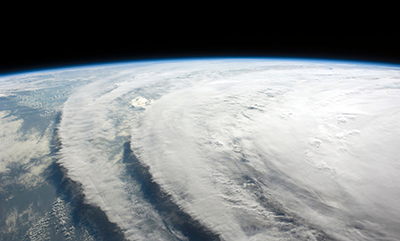When It Comes to Post-Disaster Mental Health Problems, Place Matters.
 The risk of post-disaster mental health problems and the odds of recovery over time vary depending on residents’ proximity to the disaster and the individual- and community-level factors present at different locations, according to a new study co-authored by a School of Public Health researcher.
The risk of post-disaster mental health problems and the odds of recovery over time vary depending on residents’ proximity to the disaster and the individual- and community-level factors present at different locations, according to a new study co-authored by a School of Public Health researcher.
The study, in the Nature journal, Scientific Reports, analyzed trauma exposure, social supports, and other factors among 561 residents of Galveston and Chambers counties in Texas in the months after Hurricane Ike hit the area in September 2008. The research team, which included senior author Sandro Galea, dean and Robert A. Knox professor, detected a cluster of chronic post-traumatic stress symptoms (PTSS) on Galveston Island, close to the area where the hurricane made landfall. The risk of suffering from chronic PTSS was nearly five times higher inside the cluster than outside, and was also higher for people who lost sentimental possessions or pets, suffered financial losses, or were 55 years old or older.
Understanding such “longitudinal trajectories” of post-disaster mental health, including resilience and recovery after trauma, is “crucial to identifying vulnerable regions and populations” so that mental-health services may be targeted to those who need help the most, the authors said. The study is the first to show that variations in such trajectories are tied to geographic location, as well as to individual and community factors.
The authors note that weather-related disasters, including tropical storms, are increasing in the US and globally due to climate change.
“In the immediate aftermath of a disaster, early responders may be guided towards those mostly in need, whereas in the longer-term, mental health consequences could be mitigated through early detection of mental health needs in the population,” the researchers said.
The study found that people living in areas more heavily affected by the hurricane were at higher risk for chronic or delayed mental health problems—bolstering the idea that post-disaster symptoms can be largely explained by geographic differences in trauma exposure. In addition, local socio-ecological conditions—such as age, ethnicity, and social supports—are factors in long-term outcomes.
Residents of areas with higher social cohesion and support reported higher rates of resilience and recovery than those with lower levels of such resources. Also, people with pre-disaster psychological problems were more likely to experience PTSS.
The research team identified a secondary geographic cluster, spanning from Santa Fe to Texas City, where residents were found at a higher risk for delayed PTSS. One explanation for the finding was that Texas City experienced long-term difficulties because of heavy rainfall and water and sewage outages, the authors said.
Residents in another area, Kemah, had a higher likelihood of resilience after depression, which the research team attributed to a combination of individual- and community-level factors. Residents within the Kemah “resilience cluster” had higher education and income levels and reported lower hurricane damage than those on Galveston Island.
“In certain areas, due to a combination of advantageous individual- and community-level factors, the association between known risk factors and psychiatric adversity may be reduced,” the researchers said.
The study was led by Oliver Gruebner, a research fellow at the Harvard T.H. Chan School of Public Health and a former postdoctoral trainee working with Galea. Co-authors were from Montclair State University, State University of New York, University of Minnesota Twin Cities, University of California at Davis, and Geisel School of Medicine at Dartmouth.